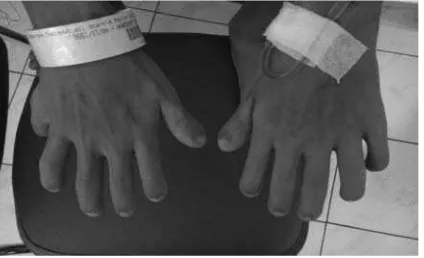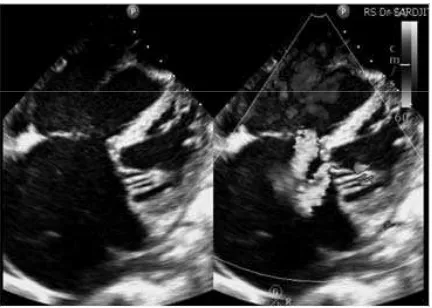Apshanti et al., 2015
86
Common Atrium In Ellis Van-Creveld Syndrome
Kartika Apshanti, Irsad Andi Arso, Bambang Irawan
Department of Cardiology and Vascular Medicine, Faculty of Medicine Universitas Gadjah Mada – Dr. Sardjito Hospital, Yogyakarta, Indonesia
Abstract
Single atrium is a complete absence of atrial septum.1 It is often found in Ellis-van Creveld Syndrome. Ellis-van Creveld Syndrome is a chondral and ectodermal dysplasia that is characterized by short ribs, polydactyly, growth retardation and also ectodermal and heart defects. We report a male, 18 years old who came with worsening of dyspnea. At physical examination we found short stature, polydactyly, cardiomegaly, severe scoliosis, genu valgum and nail hypoplasia. Transthoracic echocardiography showed the complete absence of atrial septum with signs of pulmonary hypertension.
Keyword: common atrium, Ellis-van Creveld Syndrome, polydactyly
Introduction
Complete absence of the atrial septum is rare and is considered to be the least common variety of atrial septal defect. It is a condition where the atrial septum is completely absent or only the vestigial element of a poorly developed atrial septum is present. 1,2 This condition is most commonly seen with Ellis-van Creveld syndrome.2 Ellis-van Creveld Syndrome is a chondral and ectodermal dysplasia characterized by short ribs, polydactyly, growth retardation and ectodermal and heart defects. It is a rare case with approximately 150 cases reported worldwide.3 Congenital heart disease happens in patients with Ellis-van Creveld Syndrome, 60% of which is single atrium. 4 This paper will report a case of common atrium in Ellis-van Creveld Syndrome.
Case Report
A male, 18 years old, came with worsening of dyspnea, since 3 months ago. The dyspnea on effort had been felt for 5 years, but it worsened in the last 3 months. There was no history of chest pain, leg edema, fainting or bluish lips, skin or mucosa before. Patient was born in a normal delivery, with good birth weight. It’s said that when he was 5 months old, there were 2 teeth (incisivus) growing from upper gingiva. He was said to have a lung infection when he was 4 years old, and he had medication for that for a whole year. He seemed to be shorter and different from his peers, but his development and intelligence were otherwise normal and there was no same complaint in the family.
[image:1.595.312.524.546.675.2]At the initial physical examination, patient seemed to have shortness breath, blood pressure was 110/70 mmHg, heart rate was 120 times per minute, regular, respiratory rate was 30 times per minute, body temperature was 36.2 ºC, peripheral oxygen saturation was 88-90%. The thoracic cage was asymmetrical, there was severe scoliosis. There were rales in the basal of the lungs. There was cardiomegaly. The cardiac apex was palpated at 5th intercostal space anterior axillary line, the right heart border was at right parasternal line. First heart sound is normal, but there was wide fi xed splitting of second heart sound. There were diastolic murmur 2/4 at 2nd intercostals space in left parasternal line, systolic murmur 3/6 at 4th intercostals space in left parasternal line and at apex. There was RV heaving.
Figure 1. Polydactyly at the hands with sausage-shaped fi ngers
Acta Cardiologia Indonesiana (Vol 1 No. 2): 86-88
87 at the superior part of tibia. There were six fi ngers at each hand and there were fi ve fi ngers at each foot (Figure 1). The fi ngers were short and had sausage-like morphology. The nails were hypoplastic. The extremities were warm, no edema or clubbing fi ngers. The patient had short stature, the height was 120 cm, and the weight was 38 kg.
[image:2.595.71.285.277.451.2]Routine blood count revealed mildly increased haemoglobin and haematocrit, Hb was 16,3 gr/dL, Hematokrit was 48,9%, other parameters were normal. ECG revealed sinus rhythm, 100 times per minute, fi rst degree AV block, with right axis deviation, enlargement of right and left atrium and right ventricle hypertrophy (pressure type).
Figure 2. Chest X-Ray revealing severe scoliosis and marked cardiomegaly
Chest X-Ray showed severe scoliosis and marked cardiomegaly (Figure 2). The echocardiography showed that there was no any atrial septum (common atrium) with enlargement
of right ventricle, severe regurgitation of tricuspid and mitral valve, the TVG was 51 mmHg. Echocardiography also showed that there was mitral cleft (Figure 3).
Discussion Common Atrium
Complete absence of the atrial septum is rare and is considered to be the least common variety of atrial septal defect.5 Besides its rare occasion, common atrium is often found in patient with Ellis-van Creveld Syndrome.6 Heart defects occur in 50-60% of these patients; the most common anomaly is a common atrium (40%).7 Levy and associates recommended that the term single atrium should be used to denote the condition characterized by: a) complete absence of the atrial septum, b) absence of the malformation of AV valve and c) absence of the Intraventricular (IV) communication. They suggested that the term common atrium (CA) should be used to denote the condition of complete absence of atrial septum, accompanied by malformation of AV valves with or without I.V. communication.8
In cases of complete absence of the atrial septum without an endocardial cushion defect (single atrium), single atrium can be asymptomatic or patient may show dyspnea on effort and frequent upper respiratory infections. On the other hand, in cases of complete absence of the atrial septum with an endocardial cushion defect, patients seem to show a decrease in exercise tolerance early in life, increased fatigability, shortness of breath, mild cyanosis or obvious heart failure.1,8
The physical findingsin single atrium are typically those of atrial septal defect of the fossa ovalis type. There is prominence of the precordial area, a soft systolic murmur at the pulmonary area and a constant wide splitting of the pulmonary second sound. In common atrium, in addition to the above mentioned physical signs, there is a high pitched systolic murmur at the apex radiating towards the axilla, characteristic of mitral regurgitation.1,8 The ECG features of single atrium are PR interval prolongation, left axis deviation and right ventricular hyperthrophy signs. 8
The radiologic fi ndings is similar to those found in the ordinary type of atrial septal defect, namely: cardiomegaly of variable degree due to enlargement of the right cardiac chambers, with normal left cardiac chambers. Often there is a prominent pulmonary artery segment at the hilar vascular shadow, and Figure 3. Apical four chamber view of transthoracic
[image:2.595.72.288.564.718.2]Apshanti et al., 2015
88 plethora of the peripheral branches of the pulmonary vasculature.1
Common atrium treatment is surgical correction by forming atrial septum using Tefl on, Dacron, or pericardial patch. The mitral valve cleft is repaired.1,8 A case report presented a nine months old single atrium patient with pulmonary hypertension treated with surgical correction of the atrial septum with fenestrated patch. The patient then had a targeted pulmonary hypertension therapy using oral endothelin receptor antagonist. The patient was doing well, the pulmonary artery pressure normalized after 5 years.9
Ellis-van Creveld Syndrome
Ellis-van Creveld is a syndrome that affects many organs.3 This rare condition is inherited as an autosomal recessive trait. Mutations of the EVC1 and EVC2 genes, located on chromosome 4p16, have
been identifi ed as causative. 2 A clinical tetrad of Ellis– van Creveld syndrome consists of chondrodystrophy, polydactyly, ectodermal dysplasia, and cardiac anomalies.7 Chondrodystrophy can be dwarfi sme and progressive distal limb shortening. Ectodermal dysplasia can manifest as nail hypoplasia, abnormally shaped teeth, and neonatal teeth. Musculoskeletal anomalies include low-set shoulders, a narrow thorax frequently leading to respiratory diffi culties, knock knees (genu valgum), lumbar lordosis, broad hands and feet, and sausage-shaped fi ngers. 7
Congenital heart disease happens in half of Ellis-van Creveld Syndrome patients, 60% of which is common atrium.4 Persistent left superior vana cava and pulmonary venous connection abnormalities also common in Ellis-van Creveld Syndrome.6 The cardiac anomaly is the major cause of shortened life expectancy.7
Review of the cardiac phenotype in patients with EVC syndrome reveals a characteristic pattern of atrioventricular canal defects with systemic and pulmonary venous abnormalities. Emerging molecular and developmental studies suggest that EVC and EVC2 proteins may be important for cilia function. It is speculated that coordinate function between the EVC proteins is required for a cilia-dependent cardiac morphogenesis.7
Early detection of Ellis-van Creveld Syndrome can be done by prenatal abnormalities ultrasound examination, this include narrow thorax, shortening of long bones, hexadactyly and cardiac defects.3 Ellis-van Creveld Syndrome management is
multidisciplinary, and early diagnosis is important for effi cient and prompt treatment in a timely fashion. A holistic view is needed when assessing a patient with congenital heart disease.10
Summary
We reported a rare case of common atrium in Ellis-van Creveld Syndrome in an 18 years old male. In congenital heart disease patient that happen as a part of certain syndromes, an early detection and a comprehensive multidiscipline management must be done to increase patients’ life expectancy and quality of life.
Reference
Hirai S., Hamanaka Y., Mitsui N., Isaka M., 1.
Mizukami T. 2003. Surgical repair of a common atrium in an adult. Ann Thorac Cardiovasc Surg, 9(2):130-133.
Park M.K. 2008. Pediatric Cardiology for 2.
Practitioners 5th ed. Mosby Elsevier, Philadelphia.
Baujat
3. G., Le Merrer M. 2007. Ellis-van Creveld. Orphanet J Rare Dis, 4;2:27
Sajeev CG., Roy TNS., Venugopal K. 2002. 4.
Common atrium in a child with Ellis-van Creveld syndrome. Heart 88(2): 142
Ramesh B., Roop Singh V., Ravikanth. 2014. 5.
Single atrium in 42 year old male. Scholars J Med Case Rep, 2(3):190-191.
Hills CB.,
6. Kochilas L., Schimmenti LA., Moller JH. 2011. Ellis-van Creveld syndrome and congenital heart defects: presentation of an additional 32 cases. Pediatric Cardiology, 32(7): 977-982 Chen H., Buehler B., Fasullo M., Windle M. 7.
L., Flannery D., Rauch D., Laufer-Cahana A. 2013. Ellis-van Creveld Syndrome. http:// emedicine.medscape.com/article/943684 Levy M., Salomon J., Vidne B.A. 1974. Correction 8.
of single and common atrium with reference to simplifi ed terminology. Chest, 66(4): 444-446 Ferdman D., Ramaswamy P., Rosenzweig E.B. 9.
2010. Pulmonary arterial hypertension and common atrium. Am J Respir Crit Care Med, 181:AG219
Paiva L

